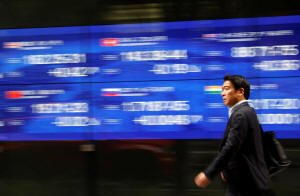Shares fall, Middle East strife boosts oil and gold
 Send a link to a friend
Send a link to a friend
 [October 18, 2023] By
Amanda Cooper [October 18, 2023] By
Amanda Cooper
LONDON (Reuters) -Global shares fell on Wednesday, while unease among
investors about the risk of a widening conflict in the Middle East
translated into a rise in the price of oil and gold.
Compounding the concern about the geopolitical situation was the
prospect of no respite any time soon from high interest rates, following
U.S. data that showed consumer spending picked up in September.
Bond markets took a battering the previous day, after U.S. retail sales
increased more than expected last month, cementing expectations that
economic growth picked up more than expected in the third quarter.
Furthermore, China reported annual economic growth of 4.9% in the third
quarter, beating forecasts for 4.4%. Separate releases there painted a
picture of a more resilient consumer, suggesting Beijing's stimulus
measures may be paying off.
Investor sentiment was fragile, as Israeli and Palestinian authorities
traded blame for the blast that killed hundreds at a Gaza hospital,
complicating U.S. President Joe Biden's already fraught trip to the
region.
The news helped push oil above $90 a barrel and fed a bid for gold,
which usually struggles when bond yields rise, but did not overshadow
the outlook for interest rates and inflation as the driving force for
markets on Wednesday.

"The dominant force remains this reality of inflation and what it means
for central banks and how U.S. exceptionalism keeps alive the risk of
upsetting the Fed down the road," Lombard Odier chief economist Samy
Chaar said.
"The dollar is not sharply on the rise and is relatively stable. The
only thing is bond yields - in geopolitical stress you would expect bond
yields to go down as a safe haven, the reality is bond yields have gone
up."
Money markets show traders are betting more heavily on the Federal
Reserve being forced to raise rates again, having recently signalled it
may not need to do so. A move in November is still seen as just an 11%
chance, but the probability for January climbed to 50% from 37%.
The market also again scaled back expectations for early rate cuts, with
no chance of a move until June and around 54 basis points of easing
implied for all of 2024.
GLOOM IN TECH STOCKS
Stocks retreated on Wednesday. The MSCI All-World index eased 0.2%,
while in Europe, the STOXX 600 fell 0.6% and U.S. stock index futures
were down 0.4-0.5%.
Tech stocks, which tend to suffer if interest rates rise, came under
pressure. Adding to the drag on the sector was a drop on Tuesday in
shares of Nvidia after news the Biden administration plans to halt
shipments to China of more of its advanced artificial intelligence
chips.
[to top of second column] |

A passerby walks past an electric monitor displaying various
countries' stock price index outside a bank in Tokyo, Japan, March
22, 2023. REUTERS/Issei Kato/File photo

Dutch semiconductor maker ASML was among those weighing most on the
European market, down 1.8% after warning of flat sales in 2024.
Markets are now awaiting earnings from Netflix and Tesla later in
the session.
Government bonds, meanwhile, attempted to recoup some losses. Yields
on the two-year Treasury note, which rose by as much as 14 basis
points to a 16-year high at one point on Tuesday, were down 2 bps on
the day at 5.193%.
Ten-year yields were down 3 bps at 4.818%, having closed 11 bps
higher the day before.
The Bank of Japan was forced to conduct an unscheduled operation to
buy JGBs to restrain a rise in yields, while in the euro zone,
German 10-year yields fell 1 bp to 2.87%.
More Fed comments are likely on Wednesday, with five officials
scheduled to speak ahead of an appearance by Chair Jerome Powell on
Thursday.
"We are in an environment where bad news is good news and good news
depends on whether it's good enough to push the Fed," Jefferies
strategist Mohit Kumar said.
"We are still in the camp of modestly long positions in risky
assets. But we are keeping positions close to home given the
geopolitical uncertainty," he added.
The rise in yields kept the U.S. dollar steady against a basket of
currencies.
Safe-haven flows lifted gold 1.1% to $1,945 an ounce, well above its
recent trough of $1,809. [GOL/]
Oil prices traded around two-week peaks, driven by concerns over the
Middle East and data showing a fall in crude stocks.
Brent rose 2.6% to $92.21 a barrel, while U.S. crude rose 2.7% to
$89 per barrel.
(Additional reporting by Wayne Cole in SydneyEditing by Emelia
Sithole-Matarise and Mark Potter)
[© 2023 Thomson Reuters. All rights
reserved.]
This material may not be published,
broadcast, rewritten or redistributed.
Thompson Reuters is solely responsible for this content.
 |